
New York City Independent Budget Office
FISCAL IMPACT OF INTRO. 205,
PREVENTING LEAD POISONING IN CHILDREN
A LEGISLATIVE ALTERNATIVE TO LOCAL LAW 1
Methodological Appendix
|
This report provides a detailed description of the assumptions and methodologies employed to calculate the fiscal impacts presented in IBO's "Preventing Lead Poisoning in Children: Fiscal Impact of a Legislative Alternative to Local Law 1," of April 28, 1999. Intro. 205 is a proposed bill to address the health hazards to New York City children posed by the presence of lead-based paint, introduced by Councilmember Stanley E. Michels, at whose request this analysis was performed. Intro. 205 is a legislative remedy to a court order to the city to implement Local Law 1 under a stringent interpretation. Local Law 1, enacted in 1982, requires landlords (including the city) to fully remove or cover all lead-based paint in any dwelling unit occupied by a child six years old or younger. The law established a presumption of lead-based paint in units built prior to 1960 (the year in which the city banned the use of lead paint inside dwelling units). Although Local Law 1 (LL 1) has been on the books since 1982, the city has regularly been sued for non-enforcement. A lawsuit brought by the New York City Coalition to End Lead Poisoning (NYCCELP) resulted in a court order in 19971 to the city to begin implementation of LL 1. As a result, both the Departments of Health (DOH) and of Housing Preservation and Develoment (HPD) wrote regulations which were published in early 1999. The court issued a stay, however, on implementation of the regulations until April 30, 1999 to give the City Council time to devise a legislative alternative. Intro. 205 is one such alternative. The bill proposes a lead paint hazard reduction standard of "lead-safe," requiring a lower level of remediation2 than under Local Law 1's "lead-free" standard. In return for lowering the remediation standard, Intro. 205 sets higher requirements for inspection and enforcement in the future, to ensure that dwelling units remain lead-safe. In addition, Intro. 205 mandates removal of lead-based paint in public school buildings, day-care centers, and from playground equipment. The bill also would set targets for blood screening of children. None of these other provisions is contained in Local Law 1. Costs to the city under Intro. 205 would be incurred in the following ways:
Intro. 205 also mandates lead-paint removal in classrooms, day-care centers, and playgrounds by the Board of Education and other city agencies. We anticipate no additional city costs for this, because the work has largely been performed or is currently programmed. Finally, although costs to the Human Resources Administration resulting from targeting more children for blood-lead level testing (and treatment where necessary) cannot be attributed directly to the bill, the city could incur some additional health-related costs as a result of meeting the blood-lead level screening targets in the bill. The remainder of this report is divided into 5 sections: Section 2 describes the assumptions and methodology used in calculating the costs of reducing lead paint hazards in housing, including costs of relocating families from occupied units during lead-paint hazard reduction work. Section 3 estimates the costs of the inspection requirements of Intro. 205. Section 4 discusses the requirements of Intro. 205 for lead-paint remediation in schools, day-care centers, and playgrounds. Section 5 provides the analysis of lower property tax revenues as a result of use of the J-51 tax incentive programs by private owners to help defray the costs of lead-paint hazard reduction. Finally, section 6 analyzes the medical costs that the city might incur as a result of implementing Intro. 205's recommended targets for screening of children under 6.
The costs of reducing lead-based paint hazards in dwelling units essentially boils down to the number of units, multiplied by the per-unit cost of remediation. We begin by estimating the number of units affected under both Intro. 205 and Local Law 1, then discuss the average per unit costs, and finally combine the two to estimate the annual costs to the city under both laws. Estimating The Number Of Potentially Affected Units In estimating the number of potentially affected units, we drew upon the 1996 Housing Vacancy Survey, conducted for the city by the U.S. Census Bureau. We begin by determining the number of occupied units in multiple-dwelling rental buildings built prior to 1960. Total dwelling units in the city numbered 2,995,276. Ninety-three percent, or 2,780,349 units, were occupied at the time of the survey. Public Housing accounted for 165,647 of these units, leaving 2,614,702 private or city-owned ("in-rem"3) dwelling units. We were only concerned with pre-1960 units, which are over three-fourths of the above, or 1,996,476. Of these, the vast majority were rental units: 1,711,550. Two-thirds of these, or 1,146,979, were in multiple-unit buildings. Some of these were owned by the city (21,779) and the rest, 1,125,200, were held by private owners. The Department of Health estimates that 10 percent of apartment units built before 1947, and 20 percent of those built between 1947 and 1959, used little or no lead-based paint.4 All the in-rem units identified above were built prior to 1947, while 994,465 of the private units were built prior to 1947 and 130,736 between 1947 and 1959. Discounting by these factors leaves 999,600 private units total, and 19,600 in-rem units. Some number of housing units in the city will have already undergone lead paint remediation, either as part of a general renovation or rehabilitation, or as a stand-alone effort. According to the Mayor's Management Reports, which started reporting statistics in Fiscal Year 1995, by the end of Fiscal Year 1999 some 31,666 units in private buildings will have been found to be in compliance or had lead hazard reduction work completed. Of the city's in-rem units, 2,393 will have completed lead hazard reduction. These completions include only those units where a code violation was issued (by either DoH or HPD) or a city building where tenants responded to an HPD survey. These reductions were distributed among units with lead hazards, with and without a child under 6 or 7, in proportion to each category's share of total lead-hazard units. An unknown number of other dwelling units will have undergone remediation in the course of other renovation or rehab work. We were not able to estimate how many such units there might be. We note that currently 12.2 percent of class 2 buildings citywide have a J-51 exemption or abatement (see the section on property tax analysis below). Not all of these will have been taken for rehabilitation work that reduced lead-based paint hazards, however. In the absence of any basis for making a justifiable assumption, we chose not to further reduce the totals derived above. Thus, the estimated maximum total number of privately-owned units in multiple-dwelling buildings built prior to 1960 which may still contain lead-based paint is 967,941. The comparable number for city-owned units is 17,208. Intro. 205 Intro. 205 would apply to units in multiple-unit rental buildings built prior to 1960. Section 27-2056.8(b) of the bill directs HPD and DOH to establish a remediation schedule for all units inhabited by a child under 6 and containing a lead hazard condition5, such that all such units have been remediated by July 1, 2005. The Independent Budget Office interprets the language of sec. 27-2056.8(a) as requiring that all units undergo lead paint hazard reduction, if necessary, upon vacancy. Thus, if a private landlord fails to take the necessary actions upon vacancy, HPD's emergency repair bureau would perform the work, billing the landlord for the costs. The legislation's principal sponsor, however, has said that it was not his intent that HPD perform emergency repairs in vacant units, but only in those inhabited by a child under the age of 6 and in which a lead-based paint hazard exists. Landlords have the responsibility to carry out lead-paint remediation in vacant units, but HPD would only be required to perform remediation on an emergency basis in inhabited units. The breakdown of total units by lead hazard and presence of a child is thus as shown in Table 2.1. Under the author's interpretation, only those units in the first row, with a lead hazard and child under 6, would be subject to remediation under HPD's emergency repair authority. Under IBO's interpretation, all units shown in the table would be affected, with those in the 2nd, 3rd, and 4th rows only liable for remediation upon vacancy. We provide estimates under both interpretations. To calculate the annual budgetary impact of Intro. 205, we assumed that lead paint hazard reduction would be undertaken with the following priority: units with a lead hazard and a child first, units with no hazard and a child next, then units with a lead hazard but no child, and finally units with neither lead hazard nor resident children.
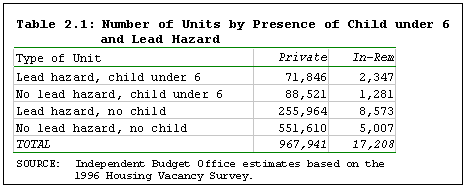 For in-rem buildings, the total number of units, 17,208, was distributed evenly over the period fiscal year 2000 to fiscal year 2007 (2,151 units annually), which corresponds to the HPD capital strategy for disposition of its inventory of in-rem units. For private units, we assumed that all units with a child under 6 (lead-poisoned or not) and a lead-based paint hazard (71,847) would be abated by the end of fiscal year 2004, as required by Intro. 205, distributed evenly by year. According to the legislative authors' interpretation, that would be the end of the story. By IBO's interpretation, the remaining 896,094 units would also require remediation upon vacancy. The vacancy rate has recently been approximately 4 percent citywide.6 This suggests that as many as 36,000 units would become subject to the vacancy clause of Intro. 205 each year. Assuming no overlap of vacant units and units with children, as many as 50,000 units would require remediation in each of the first 5 years. The resulting "schedules" of lead paint hazard reduction for in-rem and private units, through fiscal year 2005, are shown in tables 2a and 2b. As in Table 2.1, only those units in the "Lead hazard, child" row would be affected under the author's interpretation, while all units would be covered by the law under IBO's interpretation. Local Law 1 Local Law 1 applies to units in multiple-unit rental buildings built prior to 1960 in which a child under the age of 7 is present, regardless of the presence of peeling paint, deteriorated subsurface, or other condition which could constitute a lead hazard. Of the total derived above, 176,588 private units and 4,400 in-rem units had a child under the age of 7 present, and would therefore be subject to Local Law 1. As with Intro. 205, we assume that the city would perform remediation in its in-rem units over the course of 8 years, or about 550 per year. As for private units, we assumed that the city would place some 7,500 actionable lead-paint violations on average each year. This is based on HPD's fiscal year 2000 plan, as reported in the Preliminary Fiscal Year 1999 Mayor's Management Report.
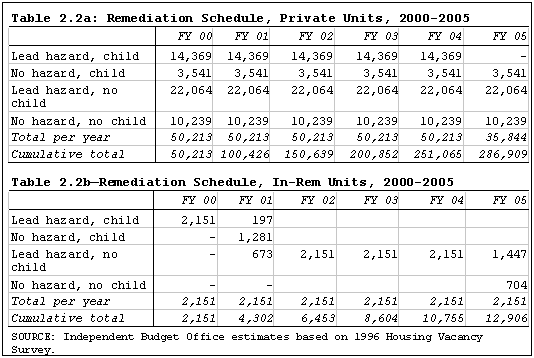 Costs Of Remediation In Affected Units We consulted cost estimates for lead paint hazard reduction work prepared by the Pratt Planning and Architectural Collaborative and by a 1993 Mayoral Task Force. For the most part, the two estimates are similar for similar scales of work (Table 2.3). Moreover, both sets of estimates correspond approximately to the cost and scope of work defined by HPD in its two current programs. HPD has two ongoing lead paint hazard reduction programs funded by its HUD Lead Hazard Reduction Grant. The first, the Primary Prevention Program, provides $7500 forgivable loans to private landlords for lead paint hazard reduction. A lower cost alternative program, the Alternate Interim Control Project, provides $3,000 grants for a reduced scale of work.7 The goal of the Primary Prevention Program is to make units "lead-safe" by eliminating lead paint on friction surfaces through repair and restoration of painted surfaces, and replacement of lead painted windows. The scope of work under the Alternative Interim Control Project may not require window replacement or repair of deteriorated subsurfaces. Additional work may be performed to eliminate lead-based paint on friction and impact surfaces of doors and kitchen cabinets, as funds permit, under both programs.
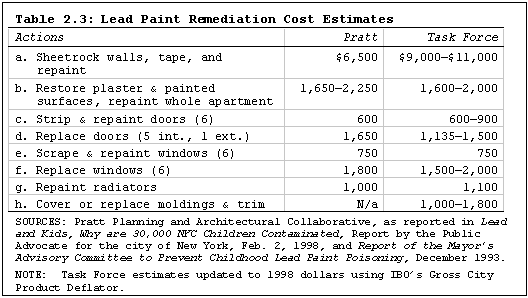 Intro 205 The bill would require landlords to take the following steps:
Using the estimates above, the costs of these actions would vary between $3,000 and $4,700 per unit for those units with peeling paint or other hazard, inhabited by a child under the age of 6: This would include actions (b), (c) or (d), and (e) or (f). For units without a lead hazard, the requirement to remove or cover lead-based paint on friction surfaces of doors and windows would cost between $1,350 and $3,650, depending on whether the landlord chose to strip and repaint, or to replace, windows and doors: (c) and (e) or (d) and (f). Where there was no child, the landlord's costs would be essentially zero until vacancy, at which time, according to our interpretation, the landlord would be required to undertake the same actions as above, except that existing law already requires landlords to eliminate peeling paint and repair deteriorated subsurfaces, and repaint (Table 2.4).
 Local Law 1 Local Law 1 requires the same action for every unit, regardless of occupancy status or condition. Based on the Pratt estimates, the cost of complete permanent covering or removal of lead-based paint on walls, doors, and windows, would total $9,950 (actions (a), (d) and (f) in the Pratt column). Various private landlords and other specialists that IBO spoke with generally cited a figure of between $12,000 and $15,000 for a typical unit, which is generally consistent with the Dinkins Task Force estimates (e.g., the same actions from the Task Force column, which yield costs between $11,635 and $14,500). We used $10,000 and $15,000 per unit as the lower and upper bounds of our estimate. Estimating the City's Lead Paint Hazard Reduction Costs The city will incur additional lead paint hazard reduction costs from two sources: (1) from additional work performed in its in-rem units in order to meet the requirements of the law, above and beyond currently programmed work; and (2) from emergency repairs performed in response to lead-paint violations placed against private units, where the landlord does not perform the work himself within the specified timeframe. Intro. 205 In-Rem Units. We concluded that the city's incremental costs for its in-rem buildings under Intro. 205 will likely be modest, because the lead paint remediation work required by the law should be in large measure already programmed under HPD's capital strategy for rehab and disposition of all its in-rem properties by 2007. In-rem buildings that undergo gut rehabilitation will be fully lead-abated - walls stripped to the brick and sheetrocked, windows and doors replaced. Buildings in the Neighborhood Redevelopment Program and Neighborhood Entrepreneurs Program, and those vacant buildings that receive Participation Loan Program funds are most often gut rehabilitated. Buildings that undergo moderate rehab may or may not be fully lead-abated, depending on the specific scope of work. However, all rehabilitation work performed using any federal Community Development Block Grant (CDBG) funds must include inspection for lead paint on all "defective paint surfaces" or "chewable surfaces," and the "covering or removal" of lead-based paint on painted or chewable surfaces when it is found.8 HPD uses CDBG funds to help finance rehabilitation of its in-rem properties prior to disposition. In practice, therefore, it is likely that HPD's moderate rehab of its in-rem units includes lead paint remediation that is substantially the same or more than that required under Intro. 205 2,226 city-owned units are slated for moderate rehab in fiscal year 2000; 357 are scheduled for gut rehab in the same period.9 We could not determine how many of the remaining inventory of buildings were slated for which kind of rehab, nor what the scope of work for moderate-rehab buildings included. If all or most units currently programmed for moderate rehabilitation include lead paint hazard reduction in their scope of work, then the additional costs could be very low, or even zero. Projecting that the ratio of moderate rehab to gut rehab will remain about the same, and assuming that 5 percent of units were to require some additional work beyond that already programmed, costs would be a relatively nominal $125,000 to $250,000 per year through 2007,10 after which the in-rem inventory is projected to be completely returned to private ownership (Table 2.5). Private Units. Where the city is most likely to incur significant additional costs under Intro. 205 (and Local Law 1) is in cases where landlords are unable or unwilling to perform the required work. This is especially likely to be true in buildings with low rent rolls, where maintenance is poor and hence the extent of required work greater, and where the owner is unlikely to be able either to obtain private financing or to raise rents as allowed under the rent regulation statute for Major Capital Improvements or 1/40th rent increases. These buildings are at risk of default because the city will be obliged to step in and perform the work and place a lien against the property to recover the costs. The consequences of this for the city budget are two-fold. First, HPD will be obliged to spend funds for remediation according to the strict timetable laid out in Intro. 205.11 Second, the city is unlikely to fully recover its costs through the lien. Since 1996, buildings in default on property taxes or other city charges, including emergency repairs, may be subject to tax lien sale. In the first tax lien sale in 1996, the city received about 60 cents on the dollar for its outstanding liens. These were widely viewed to have been the choicest properties, and the recovery rate is likely to be lower in future tax lien sales. Economically distressed buildings - defined as those with a lien-to-value ratio of 15 percent or higher - are diverted from the tax lien sale, and may be subject to 3rd-party transfer (called "direct-to-disposition").12 Many of these buildings will be foreclosed, which will automatically erase all local liens. It is difficult to predict how many landlords might default on their Intro. 205 responsibilities. Occupied units with lead-based paint hazards are more likely to be found in buildings classified as either "dilapidated" or "deteriorating" in the HVS - 3 percent and 13 percent respectively, versus 1 percent and 5 percent of units in which no lead hazards were reported. This provides one rough measure of the risk of landlord default. To meet this challenge, HPD has programmed $16.75 million in fiscal year 2000, and $25 million thereafter, specifically for a capital program for lead paint hazard reduction. This program, not yet fully up and running, will most likely provide low-interest rate loans to private landlords to perform lead paint hazard reduction work. If the loan funds were assumed to be distributed as HPD had planned to distribute its Round 6 Lead Hazard Reduction Grant Funds, this level of funding would support approximately 3,000 rehabs in the first year and 4,400 annually thereafter.13 This would represent 20 percent, rising to 30 percent of estimated private units with a lead hazard condition and a child under the age of 6. It thus seems possible that this program, along with other programs designed to support rehabilitation of private buildings, will be sufficient to meet the needs for lead-hazard reduction under Intro. 205, and avoid owners being subject to emergency repairs, particularly if the funds are targeted to those buildings most at risk.14 If we were to assume nonetheless that 1 percent of buildings were to "slip through the cracks" and require HPD intervention, HPD's immediate costs would be between $0.4 million and $0.7 million annually. Depending on the rate of foreclosure, the city could probably expect to recoup less than half this amount at best.15 We assumed no recovery of emergency repair expenditures (Table 2.5).
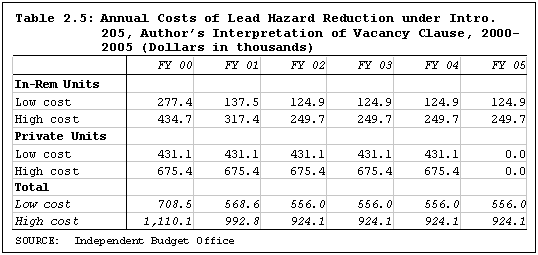 Under the IBO interpretation of Intro. 205, potential city costs for emergency repairs would be dramatically higher. First, the universe of affected units expands from 72,000 to 967,000. Second, it is likely that not only will a large absolute number of units rise, but that the rate of owner default will rise, since individual buildings will incur more costs and the city's lead-paint capital program funds will be stretched that much further. Projecting a 3 percent default rate on vacant units with lead hazards, city costs for emergency repairs would be between $2.2 and $3.8 million each year (Table 2.6).
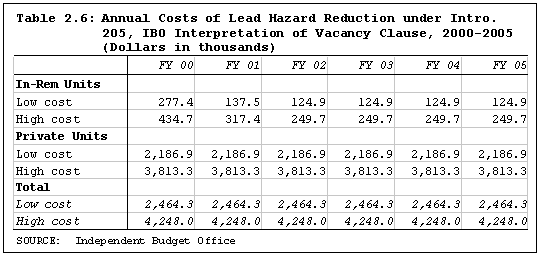
Local Law 1 Because the level of remediation required by Local Law 1 is higher, the per-unit costs are correspondingly greater. This raises the costs of remediation in the city's own units, as well as the risk of default among private buildings. In-Rem Units. The city would be required to perform lead paint remediation in units with a child under 7 - about 4,400 in-rem units, by our estimation. The incremental cost to the city would be the cost of performing the full required remediation in buildings undergoing moderate rehab (we assume that gut-rehab buildings will meet the LL 1 requirement to be lead-free) - that is, lead paint hazard reduction over and above already planned work. As noted above, we were unable to obtain any information on the number of moderate-rehab units and the scope of work. We therefore must base our estimates on plausible but hypothetical scenarios. One possible scenario is summarized in table 2.7. We assume that 75 percent of the 4,400 affected units would have their windows replaced under current moderate rehab plans. To meet the requirements of Local Law 1, the city would be required to replace the windows in the remaining 25% of units as well, at an additional cost of $2 million, and so on.
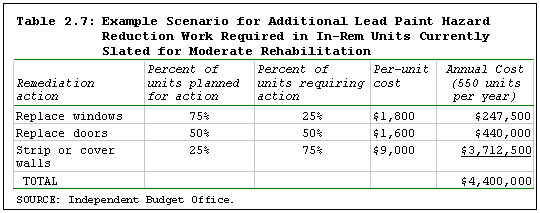 Obviously this estimate could vary substantially depending on the actual cost of the work and the percentage of moderate-rehab units that would require additional work. For example, if only 50 percent of units required sheetrocking walls, and the cost were $6,500 per unit, then the cost would be slightly under $2.5 million annually. Private Units. As with Intro. 205, the most likely, but least predictable fiscal impact would result from the city's obligation to perform the required work when the owner fails to. And again, it is difficult to predict in how many cases this might occur. Local Law 1 requires more extensive, and expensive, work. A higher percentage of affected building owners might therefore be expected to fail to perform the required work, and the city's programmed capital funds for lead paint hazard reduction will go less far. In recent years HPD has reported about 5,200 actionable lead paint violations per year, according to the Mayor's Management Report, with a projection for 7,500 in fiscal year 2000.16 At the latter rate, assuming the city would target its lead-paint capital funds to these units, but would still be obliged to undertake emergency repairs in 5 percent of private units, the estimated annual costs would fall between $2.5 and $3.8 million (Table 2.8).
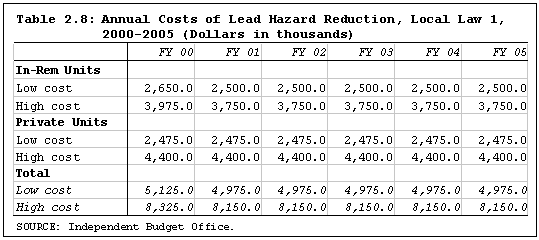 Costs To Relocate Families From Units In Which Lead Paint Hazard Reduction Work Is Being Performed. Intro. 205 HPD's 1997 HUD grant application estimated that one-half of households would require relocation during lead paint hazard reduction work, for 5 days at a cost of $150 per day, or $750 per household. It seems likely that the more limited scope of work required under Intro. 205 might allow for isolation of the immediate work area, such as with plastic sheeting, without relocation of the family. Thus, assuming a 25 percent relocation rate, the costs under Intro. 205 would be under $50,000 annually for both its in-rem and 1 percent of private units. If vacant units are also subject to remediation, then the annual costs would be over $200,000 annually. Local Law 1 The city's experience with performing gut rehabilitation in occupied units suggests that the extensive scale of work required under Local Law 1 could actually require nearly all households to be relocated during the work. In-rem units that might have been scheduled for moderate rehab but which would require more extensive rehab because of Local Law 1 could thus incur relocation costs not currently planned for. If 75 percent of households must be relocated for 5 days, annual costs for relocation would be $300,000 for in-rem units. If the city performed remediation work in 5 percent of private units with code violations, less those targeted with capital program funds, this would result in additional total spending of $100,000 million if 75 percent of families were relocated. This probably underestimates actual costs, because the extensive nature of the work required would probably necessitate a longer relocation than the five days assumed here. In fact, 30 days seems more realistic. At $2,000 per family, relocation costs under Local Law 1 would be $1.2 million annually for both in-rem and private units.
Intro. 205 would impose new inspection requirements on HPD. The bill would require that every inspection in response to any complaint of a code violation include an inspection for lead-based paint if a child under the age of 6 is found to reside in the unit. In addition, HPD must perform regular inspections of "at risk" buildings, and mandatory reinspections of units where a violation was issued (HPD regulations currently allow owners or tenants to certify that work has been completed to correct a violation without on-site verification by a housing inspector). One way to calculate the inspection burden imposed by Intro. 205 is to measure the probable number of "full-time inspector equivalents" that would be required to implement the law's inspection requirements. The resulting cost can be viewed as the opportunity cost of Intro. 205's requirements - that is, the foregone use of department resources for other enforcement activities - whether or not additional funds were expended for added enforcement personnel. City housing inspectors complete approximately 130,000 inspections annually. The provision for a lead-paint inspection when a child under the age of six is found would tend to add to the length of time necessary for each inspection, and thus somewhat reduce the total number of inspections each HPD inspection team would perform each year for a given level of enforcement resources. In addition, the 1999 preliminary Mayor's Management Report projects that some 10,000 lead paint violations will be issued in 2000, of which 2,500 will be voided or downgraded. Another 3,800 are assumed to be re-inspected. The remaining 3,700 would also require re-inspection under Intro. 205. The average inspector completes slightly more than 600 inspections per year (130,000 divided by the current 215 housing inspectors). If we assume a 3 percent reduction in the number of inspections completed each year per inspector, plus the additional reinspection requirement, an additional 12 to 14 housing inspectors would be required in order to meet the demands of Intro. 205 without sacrificing current levels of enforcement of other provisions of the Housing Maintenance Code, at an annual cost of about $500,000 (based on a $32,000 salary and 25% fringe cost, or $40,000 per inspector). See Table 3.1. This assumes that all housing inspectors will be EPA-certified to conduct a lead paint inspection, a requirement of federal law beginning August 30, 1999. If this is not the case, then some lead-paint inspections will require a separate trip by a qualified inspector, further reducing the level of non-lead-paint Housing Maintenance Code (HMC) enforcement. If inspectors completed 5 percent fewer inspections per year, 18 additional inspectors would be needed to meet Intro. 205's requirements, at an annual cost of $700,000. HPD foresees an increase in the number of housing inspectors to 240 in fiscal year 2000.17 This would be enough inspectors to fulfill Intro. 205's requirements without an increase in the budget for code enforcement. Even with additional resources for enforcement, however, these are housing inspectors who could have been deployed to other, perhaps equally worthy uses if Intro. 205's inspection provisions for lead-paint violations were more consistent with other housing maintenance code enforcement. Training is another cost, although one that will be incurred I'anyway to meet new federal requirements. It is unknown for how many inspectors HPD currently intends to seek EPA certification. The more that are trained, at a relatively modest cost, the more efficient will be inspections. HPD has recently sent some code enforcement personnel to a comprehensive 5-day course offered by Cornell University, at a cost of $550 per person. The cost of training 240 housing inspectors would thus be $132,000. Other personnel, including lead-abatement workers and supervisors must also be trained.
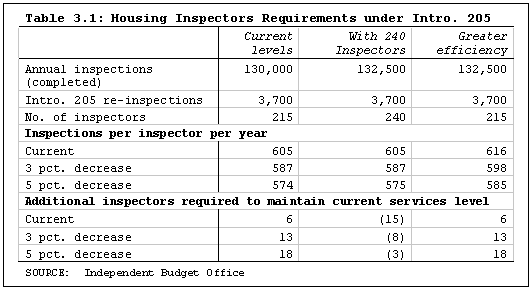
The incremental costs of lead-paint reduction in schools, day-care centers, and playgrounds is likely to be negligible, since such work is already covered under BOE and Health Code regulations and New York state law. The Board of Education currently conducts an annual survey of its facilities for lead-paint hazards, and makes any necessary repairs during school breaks and vacations, targeting facilities used by children 6 and under (kindergarten, pre-K, first-grade, and day-care facilities) and special education students. In its most recent capital plan, BOE reports having remedied lead conditions in 5,000 classrooms. We believe that BOE's current program will meet the requirements set out in Intro. 205 for lead-paint removal in school facilities, and that BOE will not incur any additional costs as a result of Intro. 205. The Board of Health adopted amendments to the Health Code in 1995 affecting kindergarten classrooms in public elementary schools which would achieve substantially the same result. In 1996, the Board of Health also amended the Health Code to address lead paint hazards in day-care facilities. Family day-care services (those offered in private homes) are subject to the Health Code and, if in multiple dwelling buildings, to the Housing Maintenance Code, and we assumed that the latter were subsumed in the analysis in Section 2. Intro. 205 does require a written plan for any abatement project greater than $2,500, overseen by an EPA-certified inspector and subject to regular inspection by HPD. Such a requirement would further add to the inspectors needed by HPD and DOH. We were not able to estimate separately how many projects over $2,500 might be completed. We also were not able to estimate the cost of the semi-annual survey for lead-based paint hazards in school facilities required by the law.
Estimating property tax revenue losses due to the J-51 tax program depends on the number of owners who would be eligible and who would then elect to apply for the exemption or abatement.18 The J-51 tax incentive program is available for rehabilitation of existing multiple dwelling buildings. It has two components: (1) a partial abatement of existing taxes based on the cost of the eligible work, and (2) an exemption from taxation on the increase in assessed value resulting from the eligible work. Abatements are more common, by about 3 to 1, because they do not require an assessor to evaluate the property. Under the abatement, property taxes may be reduced by up to 8.33 percent of the cost of the work, up to a maximum of either 90 or 100 percent of the cost, for up to 20 years. The 90 percent maximum applies to Major Capital Improvements, which are building-wide systems improvements, such as replacement of heating, plumbing or roofing systems, or installation of new windows. The 100 percent maximum applies to Moderate Rehabilitation projects, which must have a value of at least $2,500 per unit, and during which the property must remain substantially occupied. The exemption lasts for 14 or, for moderate rehab projects, 34 years, with a four-year phase-out period in both cases. In examining city property tax data, we found the following:
Why have so few capped buildings taken J-51s? One can hypothesize several reasons. The per-unit cost of eligible improvements may be higher than in a larger building (as suggested by the larger exemption values), making financing more difficult for owners, who may have lower operating reserves and less access to credit than larger buildings, many of which are owned by large development companies with more extensive financial resources. The majority of capped rental buildings are located in poorer areas of the city, where the financial resources of owners are likely to be thin. Even when they do undertake eligible rehabs or improvements, owners may not be as aware of the availability of tax benefits, or have the administrative capacity to apply for them. Adjusting the HVS numbers for the ratio of capped to non-capped buildings from the property tax files, we estimate that, of the approximately 88,100 HVS units identified as having a lead hazard and a child under 6, 17,400 - 20 percent - are in capped buildings. The remaining 70,700 units with children and a lead hazard are in larger buildings. Children under 6 disproportionately live in capped units with lead hazards - 23 percent of such units contain a child under the age of 6, while 13 percent of non-capped units with no lead hazard contain a child. If we assume that the historical percentages of buildings taking J-51 benefits holds true for future lead-paint remediation work, then we estimate lost property tax revenues at between $4.2 million and $8.3 million, depending on the scope of work performed, by the end of fiscal year 2004 (Table 5.1).
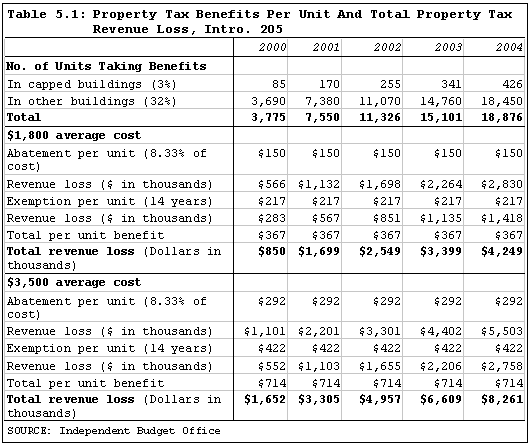 If HPD were to more aggressively "market" the availability of J-51 benefits among capped building owners, such that they took the benefits at the same rate as larger buildings, then the annual cost in lost property taxes would rise to between $5.1 and $9.9 million. Current (FY 1998) total costs of J-51 benefits are $160 million. In contrast, Local Law 1 would eventually cost the city $20 million in lost property tax revenues by our estimate. This estimate follows our previous assumption that the city places 7,500 violations annually, and assumes that 12.2% (the overall average) of owners will avail themselves of J-51 benefits. Since the cost of the required work is $10,000 to $15,000 per unit, the benefits quickly exceeded the average $943 annual tax levy on non-J-51 units. We therefore capped the total benefits at $943 per unit per year (Table 5.2).
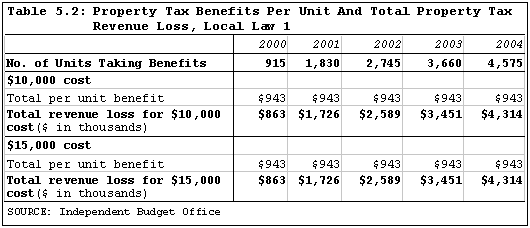
Intro. 205 sets recommended targets for higher rates of blood-lead screening among children under 6, but does not directly require any action by the city to meet these targets. In this sense, the bill does not impose any medical-related costs on the city. In particular, nothing in the bill would require DOH or any other city agency to actually perform screening, diagnosis, or treatment. Nevertheless, the bill's intention is clearly to increase the number of children screened above current levels (41 percent as of 1996, according to DOH figures) and identify those with elevated blood levels in need of further monitoring or treatment. We have estimated the costs the city would incur if the bill's screening targets - 75% of children under 6 in the first two years of implementation and 90% thereafter - were met. New York state law already mandates universal testing of 1 and 2 year olds, so some of the additional screening, treatment, and environmental inspection costs resulting from the implementation of Intro. 205 should be attributed to the Lead Poisoning Prevention Act. These additional costs include:
Screening Estimates and Projections for the City The most recent information provided by the Department of Health (DOH) on blood lead screening rates is for 1996.19 It reported the following rates for all five of New York City's boroughs:
This results in a weighted average screening rate of 41 percent for children under six years of age.20 Since the 1996 data is the most current available, our calculations take the 41 percent screening rate as the baseline. If we apply the most recent screening rate to the estimated population under age six in New York City, then about 295,000 children are tested for lead each year. Intro. 205 calls for a 75 percent screening rate in 2000 raising the number of children screened by 245,000. In 2002, the screening target increases to 90 percent and would bring the total number of children screened to 648,000, or an additional 353,000 (Figure 6.1).
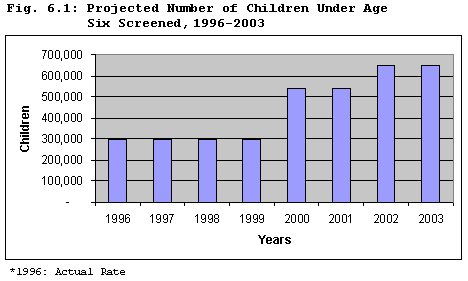 Incidence of Lead Poisoning in the City According to the 1999 Preliminary Mayor's Management Report, in the first four months of fiscal year 1999, 516 cases of lead poisoning were reported.21 Last year during the same period, 591 cases were reported ending the year with a total of 1,167 cases. Overall the number of children diagnosed with elevated blood lead levels has declined by 42.3 percent from 1995, the apex of lead poisoning cases.22 However, the number of identified lead poisoning cases is largely dependent on the number of screenings performed. The last reported screening rates from DOH was 41 percent in 1996, whereas in 1995 it had been 63 percent; a decrease of 22 percentage points. It is difficult to determine if the decline in lead poisoning cases is due to fewer children being exposed or to the fact that fewer children are being screened for lead in the blood. Whatever the reason for the decline in the incidence of lead poisoning, it is logical to expect a rise in the number of lead poisoning cases if more screenings are done. DOH generally expects about 0.8 percent of screenings to result in lead poisoning cases. Out of this 0.8 percent:
Based on the estimated increase in screenings and these figures, in fiscal year 2000 we could expect 4,323 cases of lead poisoned children. In 2002, the incidence would rise to 5,186 cases. Health Insurance Coverage Status of Children Under Age Six The city would incur costs as a function of the health insurance coverage status of children under six. This analysis assumes children are in one of four possible health coverage situations: Medicaid, Child Health Plus, private insurance, and no insurance. The city reimburses 25 percent of Medicaid costs and directly bears approximately 13 percent of the cost of serving the uninsured. Approximately 56 percent of children under six are Medicaid eligible, 7 percent are on Child Health Plus, and 10 percent lack health insurance. There are no reliable estimates as to the number of children privately insured.24 Screening Costs The screening costs to the city depend on three factors: the number of children screened, the type of test used, and the health coverage status of the child. DOH advocates the use of venous blood tests because they provide more reliable and less contaminated results. In 1998, DOH estimated the cost of testing a child to be roughly $7.00 per test.25 According to IBO calculations, if the recommendations of Intro. 205 were implemented for fiscal year 2000, additional screenings could cost the City an additional $262,000 rising in 2002 to $378,000 (Table 6.1).
 Treatment Costs The treatment costs to the City depend on the type of treatment used and on the severity of the poisoning. DOH has guidelines for treating a child based on the blood lead levels reported. For low levels, DOH keeps the child under surveillance for a few months and follows up with re-testing. At higher levels, oral chelation is typically used and at extremely high levels, intravenous chelation is administered. Treatment is also largely dependent on the discretion of the medical provider who has ultimate say on the course of treatment given to the child; this varies widely from doctor to doctor.26 Since cost of treatment estimates for New York City were not obtainable, national cost estimates were used and adjusted for New York City costs. Surveillance and re-testing is the least expensive treatment option; we assume it costs the same as an initial screening which is $7.00. Oral chelation costs anywhere from $200 to $400 for a 19 day course of treatment. We estimate New York City costs at $271. Intravenous chelation, the most expensive option, runs from $1,500 to $3,000 for 5 days of treatment with the national average being $1,843; the estimate for New York City is $1,972.27 IBO estimates that the additional costs to the city for treating lead poisoned children will be roughly $139,000 in 2000 and $178,000 in 2002. The analysis assumes the following: 25 percent of children with lead levels ranging from 20 to 44 micrograms per deciliter will only require follow-up screening; three quarters of the children poisoned from 20 to 44 micrograms per deciliter receive oral chelation; all children poisoned 45 micrograms per deciliter and above receive intravenous chelation (Table 6.2).
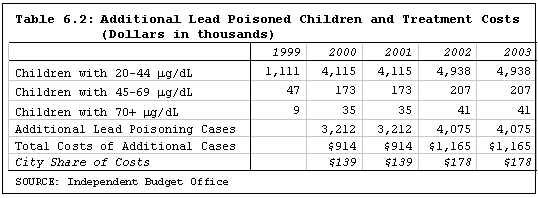
|